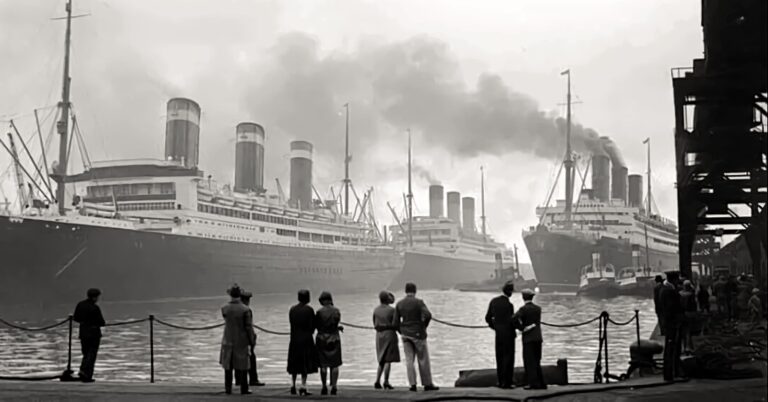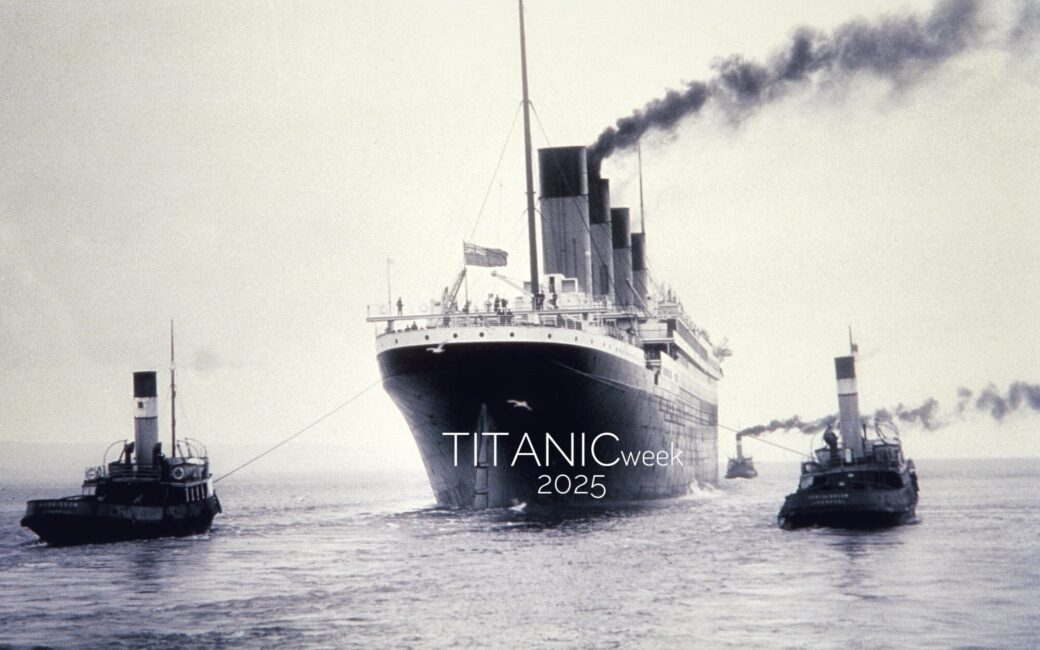"Knots of Sailors Who Stand Idly About": Recruitment Day
April 6, 1912, was a day of great relief in port city of Southampton, England.

Sister ships Berengaria, Leviathan, and Majestic docked in Southampton. Taken prior to 1931 by an unknown party.
By April 6th, the United Kingdom national coal strike had already been ongoing for 37 days. It had summarily devastated Southampton’s maritime workforce, forcing hundreds of ship workers into unemployment.
"Daily the ranks of unemployed are swelled," reported the Southern Daily Echo, "to join the knots of sailors who stand idly about."
Smoke no longer climbed from chimneys as households, in spite of the wet English chill, rationed what little coal they had left. Families were led into destitution, causing many to apply for aid and relief funds.
A contemporary newspaper report described one waiting line on Bargate Street as a "mournful queue of the workless" that had sadly become a "daily spectacle... many of the women had little tiny tots in their arms, and if some were too tired, worn and helpless to talk to each other, they hugged the sunny side of the road... [because] warm petticoats had been pawned days ago to provide food."
The periodical Southern Daily Echo reported on March 21, 1912, that
"That distress in the industrial parts of Southampton is becoming more acutely felt is shown by the abnormal number of applicants for admission to the Workhouse, and a steady increase in the number of applicants for shelter at the vagrants’ ward. Without fuel, and almost without bread, the lot of many unskilled workers and their families is a parlous one.”
It reiterated on April 4, 1912, the following as reports of the strike’s resolution loomed.
“There are many innocent sufferers from the present industrial upheaval, who have no direct interest in the strike, and will derive no benefit whatever happens. The casual dock labourer at the best of times lives more or less from ‘hand to mouth’... Every day that passes enlarges the zone of distress.”
And so, on the morning on April 6, 1912, the Miners Federation came together to vote on a “return to work” measure. After a reportedly spirited debate that carried on for two or three hours, they voted in favor. With that, the coal strike was at last done.
Southampton’s population was desperate to get back to work.
And thus, Recruitment Day began.
It must be emphasized that the Titanic and her peers did not come prepackaged with staff.
All manners of crew were employed on a contract-by-voyage basis, and they were recruited or otherwise picked up at various ports prior to departure--and even on the day of, according to some reports.
On the morning of April 6, 1912, Titanic had been berthed in Southampton for less than three days, having arrived on Wednesday, April 3rd, just shy of midnight. She had since been docked in Berth 44.
The coal strike had not prevented any and all persons in Southampton from obtaining work. But of those who had been restricted and without work for the duration of the strike, many were some of the poorest in the community.
Never the less, because the White Star Line had insisted on keeping its vessels on schedule regardless of the strike, some more fortunate men had been able to “sign on” to Titanic in the previous days: some, able seamen who left for Belfast back in late March, in order to board Titanic for her delivery voyage to Southampton; some, the likes of stewards and shopkeepers with prior experience.
By April 6th, cargo had begun to arrive at the White Star dock. And with the strike having ended that very morning, masses of heretofore unemployed men also gathered.
The White Star Dock, accessible via Dock Gate 4, was reportedly mobbed.
The White Star Line’s office on Canute Road, only a brief walk away, was likewise managing an enormous crowd.
Union halls, particularly those belonging go the British Seafarers Union and the National Sailors and Firemens Union, were thronged with hundreds more workers hoping to land a gig on Titanic.
The process to sign on to a vessel was a chaotic one.
For those with prior seagoing experience, this mandated certificates of discharge and satisfactory performance on previous vessels. Regulars from similar vessels, or even a sister ship such as Olympic, of course orbited and were favored. It was a further attestation of one's competency and character to have previously served.
Violet Jessop, a stewardess on Titanic, wrote vividly of her memories of the process as she observed it years before Titanic, when she entered into seafaring life via another shipping company.
"The clerks seemed to sense my discomfiture and courteously gave me instructions where to go in order to obtain a health certificate from the company’s doctor, a necessity before I would be allowed to sign… as I came out, I found the escort thoughtfully sent by the clerk in charge of our "Articles" to conduct me back to the Board of Trade… When the shipping master appeared, there was a surge of anxious faces, each group of men clustering around the representative of the company they hoped to get taken on by. Then, employers could choose their men… Each discharge book – a seaman’s passport – was examined, and many questions asked. When the final sorting was done, and the rejected one stood aside to make room for their more fortunate, brethren, the shipping master called for silence, in order to read aloud the "Articles of Agreement."
Jessop, Violet. "Titanic Survivor: Memoirs of Violet Jessop Stewardess." The History Press, 2007.
The jobseekers signed the Articles without paying much heed to the details therein. According to Violet, it was routinely assumed that the employer would have, and dearly keep, the upper hand regardless.
Violet went on to describe the bedlam of the scene.
"The deafening babble of tongues died down and attention, not un mixed with all, was according to him… In that seething mass there was an impulse to stick together, although loyalty played no part in it. This was the herding instinct of creatures up against things; some found themselves befriending people they would not associate with on better acquaintance."
Jessop, Violet. "Titanic Survivor: Memoirs of Violet Jessop Stewardess." The History Press, 2007.
By the time Titanic departed on April 10th, she had necessitated the employ of literal hundreds in Southampton.
Per the British Board of Trade, 908 crewmembers were aboard Titanic in total.
And of that number, a staggering 724 crewmembers signed onto Titanic's maiden voyage with a Southampton address.
SOURCE MATERIAL
Jessop, Violet. "Titanic Survivor: Memoirs of Violet Jessop Stewardess." The History Press, 2007.
https://plimsoll.southampton.gov.uk/SOTON_DOCUMENTS/titanic/Titanic_Street_Index_2012.pdf
http://sotonopedia.wikidot.com/page-browse:coal-strike-1912
https://www.titanic.memorial/post/memorial/canute+chambers+southampton/
https://www.encyclopedia-titanica.org/community/threads/stoker-trimmer-employment-on-titanic.35847/
share


